CRITICAL INTRODUCTION
THE EVERGREEN: A NORTHERN SEASONAL
VOLUME 4: WINTER 1896/97
In December 1896, The Evergreen: A Northern Seasonal, brought out its fourth and final number, Winter, planned to sell as a Christmas book for the festive season (Grilli 25). Perhaps to entice gift buyers, the Winter volume was The Evergreen’s most aesthetically attractive yet, with twelve bold black-and-white drawings and striking head- and tailpieces by the magazine’s accomplished group of artists weaving through an appealing variety of essays, poems, legends, and stories. As befitted the season, the central motif was death, sleep, and loss, but with a remembrance of, and hope for, renewed fruition in the pruned tree and unseen, germinating seed (J. A. Thomson 8). This aspect of the natural cycle was also integral to the magazine’s call for renewal in individual, civic, national, and global life. Fiona Macleod’s legendary tale, “The Snow Sleep of Angus Ogue,” expresses this larger symbolism with the story of the “Beautiful, naked god” whose heart, over the course of his thousand-year sleep, “has been the rhythmic beat of the world,” and who represents eternal Youth and Beauty (118 and 123). Of all the Evergreen’s volumes, Winter is the most mystic and the most interested in the interpenetration of pagan and Christian symbols in the traditional spiritualism of the Celts and the contemporary concerns of the Theosophists, with whom a number of Evergreen contributors were associated.
The contents of the issue are visually framed by Nellie Baxter’s opening Almanac for Winter and Patrick Geddes’s closing design of the Philosopher’s Stone, “Lapis Philosophorum.” A native of Tayport and member of the Dundee Graphic Arts Association, Baxter painted Celtic borders for murals in Ramsay Garden and contributed numerous textual ornaments to all but the first volume of The Evergreen (Young 74). The three previous Almanacs had been created by her colleague Helen Hay. Baxter’s Winter Almanac shows equal skill in decorative patterning and symbolic design, and appears as a visual response to Hay’s Summer Almanac. While the previous design was oriented to face right, Baxter oriented her design to face left; placed side by side, the two plant shapes defining each composition’s edge reach out to touch each other, implying seasonal cycle and connection.
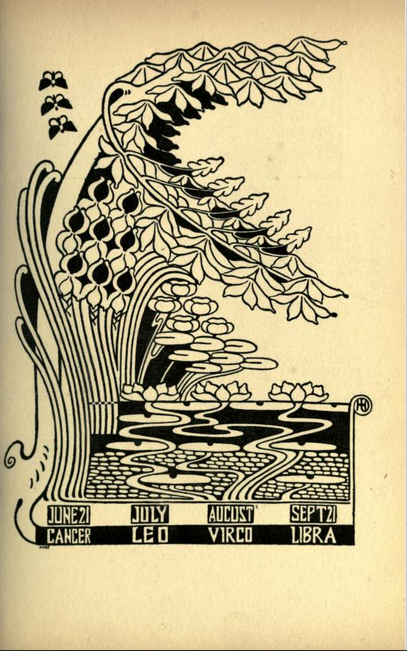
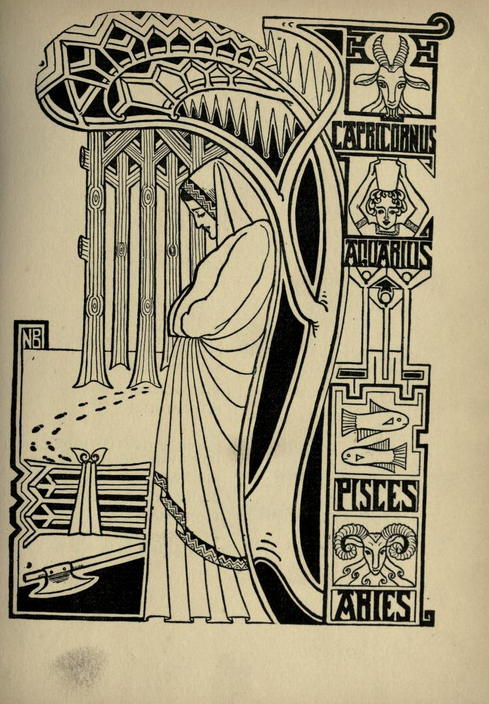
Baxter’s Almanac incorporates Winter’s four zodiacal signs (Capricorn, Aquarius, Pisces and Aries) in the form of an illuminated Celtic-style border that introduces an architectural pillar on the right-hand side of her organic design. Embraced by an encircling, stylized, tree featuring decorative snow and ice crystals, a white-robed female figure looks downward to the left, hugging her arms into her body. At left is an axe, a bundle of firewood, and tracks in the snow leading to a grove of bare trees. With its incorporation of seasonal symbols and Celtic motifs in a decorative linear pattern of positive and negative spaces, Baxter’s Almanac attests to the skillset developed around the production of the Evergreen and the restoration of Lawnmarket buildings. When the Old Edinburgh School of Art at Ramsay Garden closed later that winter, Baxter returned to Dundee, where she, John Duncan, and George Dutch Davidson established a Studio of Design and continued their artistic practice (Kemplay 21).
Signed with his initials “P.G,” but otherwise uncredited, Patrick Geddes’s “Lapis Philosophorum” concludes the final volume of The Evergreen by referencing its first: his “Arbor Saeculorum” design was the closing image of the Spring issue.
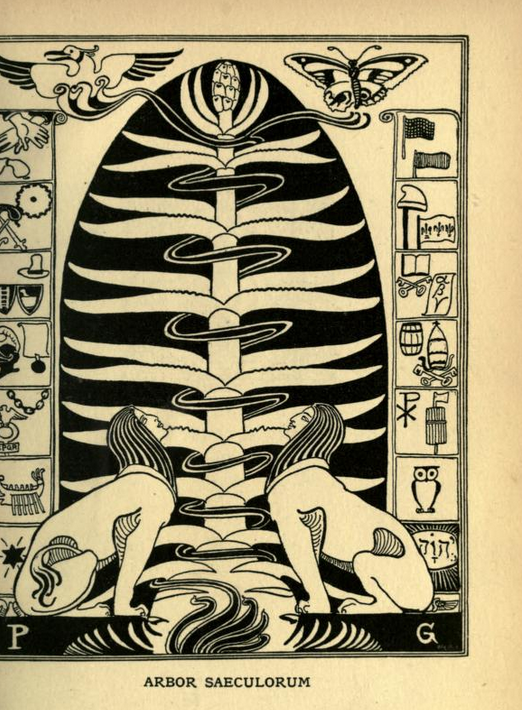

Like “Arbor Saeculorum” (Tree of History), “Lapis Philosophorum” (Philosopher’s Stone) is more of a visual concept map than a work of art. Centred on the page over three eclipsed but radiating suns is an obelisk with symbolic glyphs representing mystical, spiritual, historical, and technological human advances. Sphinxes face the stone in profile, resting on plinths on either side. As the concluding design for both volume and series, the image leaves readers with Geddes’s final word on the interconnection of all things—past and present, east and west, art and science, physical and spiritual—while also gesturing toward some of the underlying Theosophist beliefs informing The Evergreen. Both Trees of Life and the Philosopher’s Stone were important spiritual symbols for Theosophists, with the latter signifying the transmutation of human, physical nature into its highest, divine form (Blavatzky). Founded by Helen Blavatzky in New York in 1885, the Theosophical Society had an active chapter in Edinburgh in the 1890s, and Geddes, Victor Branford, and their close associates, including William Sharp, were linked with it in various ways (Scott and Bromley 51).
Some of the artists, too, were influenced by Theosophist symbolism through their connections with the French Nabi group’s decorative art, which drew on the “synthesis of mystic elements of the great religions” in its elemental designs (Mauner 99). Duncan’s “The Sphinx,” with its accompanying epigraph, addresses the metaphysical meaning of winter with iconography akin to Geddes’s “Lapis Philosophorum.” Andrew Womrath contributed to the spirituality of the season with two pictures based on Christian story. “Madonna and Child with St. John” locates the nativity in a beautiful pastoral setting, while “St. Simeon Stylites” situates the saint on a pillar by the sea, blessed by an angel. Most of the other images for the fourth volume key to the decorative seasonal motifs established in Baxter’s Almanac. James Cadenhead’s “A Cottage in a Wood,” A.G. Sinclair’s “A Winter Harvest,” W.G. Burn-Murdoch’s “Winter,” and Charles Mackie’s “Felling Trees,” express the labour of gathering enough wood for fires to combat the season’s chill. Showing the ongoing connection between architectural renewal and The Evergreen’s decorations, Womrath’s two images from Christian legend and Mackie’s “Felling Trees” design were based on murals they painted at Ramsay Garden (Willsdon 90). Mackie’s “’By the Bonnie Banks o’ Fordie,” one of his seasonal scenes of children’s outdoor play, seems out of place in this Winter number, as does Robert Burns’s “Aslavga’s Knight,” but both are strong black-and-white compositions. Simon Houfe especially praises Burns’s “marvelous piece” saying that “the artist places [horse], lance and landscape in the picture space with the geometry of a Uccello” (105). Houfe concludes: “There is no doubt that this coterie of illustrators was influenced by Japanese woodblock print in a more mature way than were most others. More subtly than their fellows they seem to grasp the spaces, the planes and the way objects need not be treated with total realism” (106)
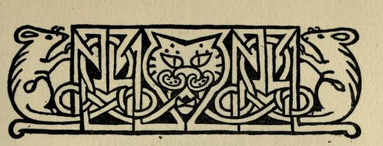
The head- and tailpieces embellishing the pages of literary content show the mastery of Celtic design and seasonal motif by Nellie Baxter, Annie Mackie, John Duncan, and new comer Effie Ramsay, who replaced Helen Hay in the Winter volume.
Featuring the angular points of ice crystals, the unique shapes of snowflakes, and the grotesque creatures that haunt the dreams of winter, the decorative devices for the Evergreen’s final volume are miniature marvels of art and design (see especially, in the Database of Ornament, Baxter 21, 22, 43, 106, 131; Duncan 28, 53, 128, 132; A. Mackie 31; and Ramsay 8, 61). With their bold lines and decorative patterns, they look both ancient and modern, particularly in such compelling decorations as Duncan’s anthropomorphic headpiece for the concluding “Envoy,” which weaves wave lines to create a figure part human, part sea creature, and altogether unique (155). Baxter and Mackie design marvelous headpieces of humans struggling with mythological beasts for W. Cuthbertson’s “Grierson of Lag” and Standish O’Grady’s “Dermot’s Spring” respectively (115 and 101). Each decorative device is designed to respond to the Winter number’s thematic concerns as a whole, and sometimes, also, to the specifics of the literary piece it decorates. With more textual ornaments than any previous issue of the Evergreen, each with the intricate beauty of Celtic jewelry and illumination, the Winter number was indeed a beautiful Christmas gift book. In admiration, the Irish Celtic Christmas reproduced some of the Evergreen’s decorative devices as “excellent specimens of modern Celtic design” (Bowe and Cumming 97).
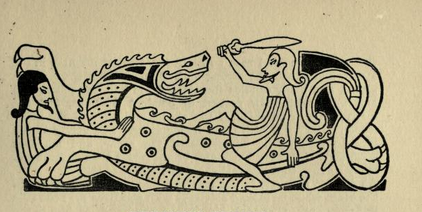
While some of the contents of the Winter volume may seem grim fare for seasonal celebrations, Victorian readers embraced ghost stories and supernatural tales as periodical pleasures at Christmas (Moore 81). J. H. Pearce’s Cornish tales about uncanny supernatural sightings, “Fantasies,” and Margaret Thomson’s legend from the Scottish Highlands, “The Story of Castaille Dubh [The Black Castle],” fit into this genre, as do poems by W. Cuthbertson (“Grierson of Lag”), Sir George Douglas (“A Winter Song”), and Nora Hopper (“All Soul’s Day).” The latter pairs well with Catherine Janvier’s “A Devolution of Terror,” an essay on rituals formed out of superstition and death among the ancient peoples of the Alpilles in Provence, and Marie Clothilde Balfour’s “The Black Month,” on the origins of November rituals in Brittany. Other supernatural pieces, often mixing pagan and Christian traditions, include Irish author Katharine Tynan’s “The Mother of Jesus,” Edith Wingate Rinder’s legend of Ireland and Brittany, “Sant Efflamm and King Arthur,” Douglas Hyde and Standish O’Grady’s gruesome Irish legends, “Christmas Alms” and “Dermot’s Spring,” and Fiona Macleod’s more mystical “The Snow Sleep of Angus Ogue.”
This material was balanced with non-fiction, including topical personal essays by some continental contributors. Dr. Edward B. Koster translated his “Impressions of Winter” from the original Dutch, while “Il Neige,” by Paul Desjardins and “Pourquoi des Guirlandes Vertes à Noël,” by Elie Reclus were published in French. Arthur Thomson’s “The Biology of Winter” introduced the volume’s themes by referencing Sleeping Beauty, the Norse god Balder, and the classical Proserpine as “fairy tales of science” that explore the cyclical need for sleep and death in the individual and the world (9). In “Megalithic Builders,” a meditation on the monuments left by ancient peoples, Geddes returns to this theme: “For divining the future, as for recalling the past, there is the same rare but open secret—Sympathy” (150). For this reason, he argues, the standing stones of Stirling still speak, just as traditional ballads bring forth the art poetry of subsequent generations (151).
The art and literature of the Evergreen’s Winter number achieve a high standard, especially when compared to the uneven contents in the magazine’s initial Spring volume. Reflecting on the completed series, Geddes and Macdonald observed: “Be it good or bad, frankly experimental at least it has been, from cover to cover” (155). They went on to describe the magazine’s organizers as a “semi-collegial group” operating without a single or consistent editor, allowing “its artists and writers” such a wide latitude of style and subject, that this might have obscured The Evergreen’s “element of organic unity, not yet manifest in form and substance, but working in life and growth” (155). The Literary World was generous in its praise of the completed series of four volumes, produced out of “a new movement” in Scotland whose youthful authors and artists were “willing to experiment and willing, we suppose, to fail” (“The Evergreen” 157). While praising, as did virtually all critics, the work of Fiona Macleod, and noting that the “salability” of this “remarkable writer” boosted The Evergreen, the reviewer also gave space to the magazine’s larger aspirations. “Very likely they are dreamers,” the reviewer wrote: “the weird mysticism of the Celt is cherished to the last degree: beyond doubt they are impractical; yet, with it all, they have made a noteworthy book of this, the closing number” (“The Evergreen” 157).
Announcing the end of its “first season-cycle,” The Evergreen’s “Envoy,” or concluding note, assured readers that, although “experience has made the possibilities and plan of a new series clearer, the time for this is not yet” ([Geddes and Macdonald] 156). The volume concludes with a final allusion to Geddes’s publishing house in the Outlook Tower, and the promise of spring’s return after a winter rest: “Hence the ‘Evergreen’ sleeps for a season, and the ‘Interpreter,’ from his different outlook, will have his say for the time” (ibid).
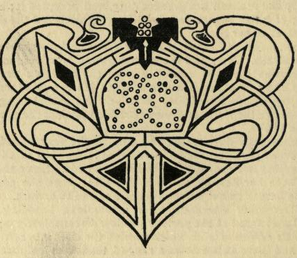
©2018, Lorraine Janzen Kooistra, Ryerson University Centre for Digital Humanities
Works Cited
- Balfour, M.C. “The Black Month.” The Evergreen: A Northern Seasonal, vol. 4, Winter 1896-97, pp. 132-137. Yellow Nineties 2.0, edited by Lorraine Janzen Kooistra, Ryerson University Centre for Digital Humanities, 2018. https://beta.1890s.ca/egv4_balfour_month/
- Baxter, Nellie. Almanac. The Evergreen: A Northern Seasonal, vol. 4, Winter 1896-97, p. 5. Yellow Nineties 2.0, edited by Lorraine Janzen Kooistra, Ryerson University Centre for Digital Humanities, 2018. https://beta.1890s.ca/egv4_almanac/
- —. Headpiece for “A Devolution of Terror.” The Evergreen: A Northern Seasonal, vol. 4, Winter 1896-97, p. 106. Yellow Nineties 2.0, edited by Lorraine Janzen Kooistra, Ryerson University Centre for Digital Humanities, 2018. https://ornament.library.ryerson.ca/files/show/316
- —. Headpiece for “A Winter Song.” The Evergreen: A Northern Seasonal, vol. 4, Winter 1896-97, p. 21. Yellow Nineties 2.0, edited by Lorraine Janzen Kooistra, Ryerson University Centre for Digital Humanities, 2018. https://ornament.library.ryerson.ca/files/show/264
- —. Headpiece for “When the Dew is Falling.” The Evergreen: A Northern Seasonal, vol. 4, Winter 1896-97, p. 43. Yellow Nineties 2.0, edited by Lorraine Janzen Kooistra, Ryerson University Centre for Digital Humanities, 2018. https://ornament.library.ryerson.ca/files/show/276
- —. Tailpiece for “The Story of Castaille Dubh.” The Evergreen: A Northern Seasonal, vol. 4, Winter 1896-97, p. 131. Yellow Nineties 2.0, edited by Lorraine Janzen Kooistra, Ryerson University Centre for Digital Humanities, 2018. https://ornament.library.ryerson.ca/files/show/328
- —. Tailpiece for “Impressions of Winter.” The Evergreen: A Northern Seasonal, vol. 4, Winter 1896-97, p. 22. Yellow Nineties 2.0, edited by Lorraine Janzen Kooistra, Ryerson University Centre for Digital Humanities, 2018. https://ornament.library.ryerson.ca/files/show/268
- Blavatsky, H.P. Theosophical Glossary, Theosophical Publishing Society 1892. http://theosophy.org/Blavatsky/Theosophical%20Glossary/Thegloss.html
- Bowe, Nicola Gordon, and Elizabeth Cumming. The Arts and Crafts Movements in Dublin and Edinburgh 1880-1925, Irish Academic Press, 1998.
- Burn-Murdoch, W. G. “Winter.” The Evergreen: A Northern Seasonal, vol. 4, Winter 1896-97, p. 77. Yellow Nineties 2.0, edited by Lorraine Janzen Kooistra, Ryerson University Centre for Digital Humanities, 2018. https://beta.1890s.ca/egv4_burn_murdoch_winter/
- Burns, Robert. “Aslavga’s Knight.” The Evergreen: A Northern Seasonal, vol. 4, Winter 1896-97, p. 19. Yellow Nineties 2.0, edited by Lorraine Janzen Kooistra, Ryerson University Centre for Digital Humanities, 2018. https://beta.1890s.ca/egv4_burns_knight/
- Cadenhead, James. “A Cottage in a Wood.” The Evergreen: A Northern Seasonal, vol. 4, Winter 1896-97, p. 19. Yellow Nineties 2.0, edited by Lorraine Janzen Kooistra, Ryerson University Centre for Digital Humanities, 2018. https://beta.1890s.ca/egv4_cadenhead_cottage/
- —. “Winter Landscape.” The Evergreen: A Northern Seasonal, vol. 4, Winter 1896-97, p. 153. Yellow Nineties 2.0, edited by Lorraine Janzen Kooistra, Ryerson University Centre for Digital Humanities, 2018. https://beta.1890s.ca/egv4_cadenhead_landscape/
- Cuthbertson, W. “Grierson of Lag.” The Evergreen: A Northern Seasonal, vol. 4, Winter 1896-97, pp. 115-117. Yellow Nineties 2.0, edited by Lorraine Janzen Kooistra, Ryerson University Centre for Digital Humanities, 2018. https://beta.1890s.ca/egv4_cuthbertson_grierson/
- Desjardins, Paul. “Il Neige.” The Evergreen: A Northern Seasonal, vol. 4, Winter 1896-97, p. 63. Yellow Nineties 2.0, edited by Lorraine Janzen Kooistra, Ryerson University Centre for Digital Humanities, 2018. https://beta.1890s.ca/egv4_desjardins_neige/
- Douglas, Sir George. “A Winter Song.” The Evergreen: A Northern Seasonal, vol. 4, Winter 1896-97, p. 21. Yellow Nineties 2.0, edited by Lorraine Janzen Kooistra, Ryerson University Centre for Digital Humanities, 2018. https://beta.1890s.ca/egv4_douglas_song/
- Duncan, John. Headpiece for “The Black Month.” The Evergreen: A Northern Seasonal, vol. 4, Winter 1896-97, p. 132. Yellow Nineties 2.0, edited by Lorraine Janzen Kooistra, Ryerson University Centre for Digital Humanities, 2018. https://ornament.library.ryerson.ca/files/show/330
- —. Headpiece for “Frost.” The Evergreen: A Northern Seasonal, vol. 4, Winter 1896-97, p. 53. Yellow Nineties 2.0, edited by Lorraine Janzen Kooistra, Ryerson University Centre for Digital Humanities, 2018. https://ornament.library.ryerson.ca/files/show/288
- —. Headpiece for “The Story of Castaille Dubh.” The Evergreen: A Northern Seasonal, vol. 4, Winter 1896-97, p. 128. Yellow Nineties 2.0, edited by Lorraine Janzen Kooistra, Ryerson University Centre for Digital Humanities, 2018. https://ornament.library.ryerson.ca/files/show/326
- —. Headpiece for “Winter.” The Evergreen: A Northern Seasonal, vol. 4, Winter 1896-97, p. 28. Yellow Nineties 2.0, edited by Lorraine Janzen Kooistra, Ryerson University Centre for Digital Humanities, 2018. https://ornament.library.ryerson.ca/files/show/270
- —“The Sphinx.” The Evergreen: A Northern Seasonal, vol. 4, Winter 1896-97, pp. 164-165. Yellow Nineties 2.0, edited by Lorraine Janzen Kooistra, Ryerson University Centre for Digital Humanities, 2018. https://beta.1890s.ca/egv4_duncan_sphinx/
- —. Title page decoration. The Evergreen: A Northern Seasonal, vol. 4, Winter 1896-97, p. 3. Yellow Nineties 2.0, edited by Lorraine Janzen Kooistra, Ryerson University Centre for Digital Humanities, 2018. https://beta.1890s.ca/egv4_titlepage/
- “The Evergreen.” Rev. of The Evergreen vols 1-4. The Literary World: A Monthly Review of Current Literature, vol. 28, no. 10, May 1897, p. 157. Yellow Nineties 2.0, edited by Lorraine Janzen Kooistra, Ryerson University Centre for Digital Humanities, 2018. https://beta.1890s.ca/eg1-4_review_literaryworld_1897/
- Geddes, Patrick. “The Megalithic Builders.” The Evergreen: A Northern Seasonal, vol. 1, Spring 1895, p0. 142-151. Yellow Nineties 2.0, edited by Lorraine Janzen Kooistra, Ryerson University Centre for Digital Humanities, 2018. https://beta.1890s.ca/egv4_geddes_megalithic/
- [Geddes, Patrick]. “Arbor Saeculorum.” The Evergreen: A Northern Seasonal, vol. 1, Spring 1895, p. 143. Yellow Nineties 2.0, edited by Lorraine Janzen Kooistra, Ryerson University Centre for Digital Humanities, 2018. https://beta.1890s.ca/egv1_arbor/
- [Geddes, Patrick]. “Lapis Philosophorum.” The Evergreen: A Northern Seasonal, vol. 4, Winter 1896-97, p. 157. Yellow Nineties 2.0, edited by Lorraine Janzen Kooistra, Ryerson University Centre for Digital Humanities, 2018. https://beta.1890s.ca/egv4_geddes_philosophorum/
- [Geddes, Patrick, and William Macdonald]. “Envoy.” The Evergreen: A Northern Seasonal, vol. 4, Winter 1896-97, pp. 155-156. Yellow Nineties 2.0, edited by Lorraine Janzen Kooistra, Ryerson University Centre for Digital Humanities, 2018. https://beta.1890s.ca/egv4_geddes_envoy-3/
- Grilli, Elisa. “Funding, Publishing, and the Making of Culture: The Case of The Evergreen.” Journal of European Periodical Studies, vol. 1, no.2, Winter 2016, pp. 19-44. http://dx.doi.org/10.221825/eps.v1i2.2638
- Hay, Helen. “Almanac.” The Evergreen: A Northern Seasonal, vol. 3, Summer 1896, p. 5. Yellow Nineties 2.0, edited by Lorraine Janzen Kooistra, Ryerson University Centre for Digital Humanities, 2018. https://beta.1890s.ca/egv3_almanac-3/
- Hopper, Nora. “All Soul’s Day.” The Evergreen: A Northern Seasonal, vol. 4, Winter 1896-97, p. 75. Yellow Nineties 2.0, edited by Lorraine Janzen Kooistra, Ryerson University Centre for Digital Humanities, 2018. https://beta.1890s.ca/egv4_hopper_souls/
- Houfe, Simon. Dictionary of British Book Illustrators 1800-1914. Antique Collectors’ Club, 1981.Hyde, Douglas. “Christmas Alms.” The Evergreen: A Northern Seasonal, vol. 4, Winter 1896-97, pp. 91-95. Yellow Nineties 2.0, edited by Lorraine Janzen Kooistra, Ryerson University Centre for Digital Humanities, 2018. https://beta.1890s.ca/egv4_hyde_christmas/
- Janvier, Catherine A. “A Devolution of Terror.” The Evergreen: A Northern Seasonal, vol. 4, Winter 1896-97, pp. 106-111. Yellow Nineties 2.0, edited by Lorraine Janzen Kooistra, Ryerson University Centre for Digital Humanities, 2018. https://beta.1890s.ca/egv4_janvier_terror/
- Kemplay, John. The Paintings of John Duncan, A Scottish Symbolist. Pomegranate Artbooks, 1994. Kooistra, Lorraine Janzen, ed. The Database of Ornament. Ryerson University Centre for Digital Humanities, 2017. http://ornament.library.ryerson.ca
- Koster, Dr. Edward B. “Impressions of Winter.” The Evergreen: A Northern Seasonal, vol. 4, Winter 1896-97, pp. 22-27. Yellow Nineties 2.0, edited by Lorraine Janzen Kooistra, Ryerson University Centre for Digital Humanities, 2018. https://beta.1890s.ca/egv4_koster_impressions/
- Mackie, Annie. Tailpiece for “Winter.” The Evergreen: A Northern Seasonal, vol. 4, Winter 1896-97, p. 31. Yellow Nineties 2.0, edited by Lorraine Janzen Kooistra, Ryerson University Centre for Digital Humanities, 2018. https://ornament.library.ryerson.ca/files/show/272
- Mackie, Charles H., “‘By the Bonnie Banks o’ Fordie’.” The Evergreen: A Northern Seasonal, vol. 4, Winter 1896-97, p. 97. Yellow Nineties 2.0, edited by Lorraine Janzen Kooistra, Ryerson University Centre for Digital Humanities, 2018. https://beta.1890s.ca/egv4_mackie_fordie/
- —. “Felling Trees.” The Evergreen: A Northern Seasonal, vol. 4, Winter 1896-97, p. 139. Yellow Nineties 2.0, edited by Lorraine Janzen Kooistra, Ryerson University Centre for Digital Humanities, 2018. https://beta.1890s.ca/egv4_mackie_felling/
- Macleod, Fiona. “The Snow Sleep of Angus Ogue.” The Evergreen: A Northern Seasonal, vol. 4, Winter 1896-97, pp. 118-123. Yellow Nineties 2.0, edited by Lorraine Janzen Kooistra, Ryerson University Centre for Digital Humanities, 2018. https://beta.1890s.ca/egv4_macleod_snow/
- Mauner, George. “The Nature of Nabi Symbolism,” Art Journal, vol. 23, no. 2, Winter 1963-64, pp. 96-103. http://www.jstor.org/stable774504
- Moore, Tara. Victorian Christmas in Print. Palgrave Macmillan, 2009.
- O’Grady, Standish. “Dermot’s Spring.” The Evergreen: A Northern Seasonal, vol. 4, Winter 1896-97, pp. 101-105. Yellow Nineties 2.0, edited by Lorraine Janzen Kooistra, Ryerson University Centre for Digital Humanities, 2018. https://beta.1890s.ca/egv4_ogrady_dermots/
- Pearce, J. H. “Fantasies.” The Evergreen: A Northern Seasonal, vol. 4, Winter 1896-97, pp. 35-42. Yellow Nineties 2.0, edited by Lorraine Janzen Kooistra, Ryerson University Centre for Digital Humanities, 2018. https://beta.1890s.ca/egv4_pearce_fantasies/
- Ramsay, Effie. Headpiece for “Between the Ages.” The Evergreen: A Northern Seasonal, vol. 4, Winter 1896-97, p. 61. Yellow Nineties 2.0, edited by Lorraine Janzen Kooistra, Ryerson University Centre for Digital Humanities, 2018. https://ornament.library.ryerson.ca/files/show/292
- —. Headpiece for “The Biology of Winter.” The Evergreen: A Northern Seasonal, vol. 4, Winter 1896-97, p 8. Yellow Nineties 2.0, edited by Lorraine Janzen Kooistra, Ryerson University Centre for Digital Humanities, 2018. https://ornament.library.ryerson.ca/files/show/262
- Reclus, Elie. “Pourquoi des Guirlandes Vertes à Noël.” The Evergreen: A Northern Seasonal, vol. 4, Winter 1896-97, pp. 79-90. Yellow Nineties 2.0, edited by Lorraine Janzen Kooistra, Ryerson University Centre for Digital Humanities, 2018. https://beta.1890s.ca/egv4_reclus_pourquoi/
- Rinder, Edith Wingate. “Sant Efflam and King Arthur.” The Evergreen: A Northern Seasonal, vol. 4, Winter 1896-97, pp. 69-74. Yellow Nineties 2.0, edited by Lorraine Janzen Kooistra, Ryerson University Centre for Digital Humanities, 2018. https://beta.1890s.ca/egv4_rinder_sant/
- Scott, John, and R. J. Bromley. Envisioning Sociology: Victor Branford, Patrick Geddes, and the Quest for Social Reconstruction, State University of New York Press, 2013. ProQuest Ebook Central, https://ebookcentral-proquest-com.ezproxy.lib.ryerson.ca/lib/ryerson/detail.action?docID=3408738
- Thomson, Arthur J. “The Biology of Winter.” The Evergreen: A Northern Seasonal, vol. 4, Winter 1896-97, pp. 8-17. Yellow Nineties 2.0, edited by Lorraine Janzen Kooistra, Ryerson University Centre for Digital Humanities, 2018. https://beta.1890s.ca/egv4_thomson_biology/
- Thomson, Margaret. “The Story of Castaille Dubh.” The Evergreen: A Northern Seasonal, vol. 4, Winter 1896-97, pp. 128-131. Yellow Nineties 2.0, edited by Lorraine Janzen Kooistra, Ryerson University Centre for Digital Humanities, 2018. https://beta.1890s.ca/egv4_thomson_castailledubh/
- Tynan, Katharine. “The Mother of Jesus.” The Evergreen: A Northern Seasonal, vol. 4, Winter 1896-97, pp. 44-47. Yellow Nineties 2.0, edited by Lorraine Janzen Kooistra, Ryerson University Centre for Digital Humanities, 2018. https://beta.1890s.ca/egv4_tynan_jesus/
- Willsdon, Clare A. “Paul Sérusier the Celt: Did he paint murals in Edinburgh?” The Burlington Magazine, vol. 126, no. 971, Feb 1984, pp. 86+ 88-91. http://www.jstor.org/stable/881466
- Womrath, Andrew K. “Madonna and Child with St. John.” The Evergreen: A Northern Seasonal, vol. 4, Winter 1896-97, p. 49. Yellow Nineties 2.0, edited by Lorraine Janzen Kooistra, Ryerson University Centre for Digital Humanities, 2018. https://beta.1890s.ca/egv4_womrath_madonna-2/
- —. “St. Simeon Stylites.” The Evergreen: A Northern Seasonal, vol. 4, Winter 1896-97, p. 125. Yellow Nineties 2.0, edited by Lorraine Janzen Kooistra, Ryerson University Centre for Digital Humanities, 2018. https://beta.1890s.ca/egv4_womrath_simeon/
- Young, Clara. “In Search of John Duncan,” The Artist and the Thinker: John Duncan and Patrick Geddes in Dundee, University of Dundee Museum, 2004, pp. 67-75.
MLA citation: Kooistra, Lorraine Janzen. “Critical Introduction to
The Evergreen: A Northern Seasonal, Volume 4: Winter 1896.”
Evergreen Digital Edition, Yellow Nineties 2.0
, Ryerson University Centre for Digital Humanities, 2019.
https://1890s.ca/egv4_introduction/